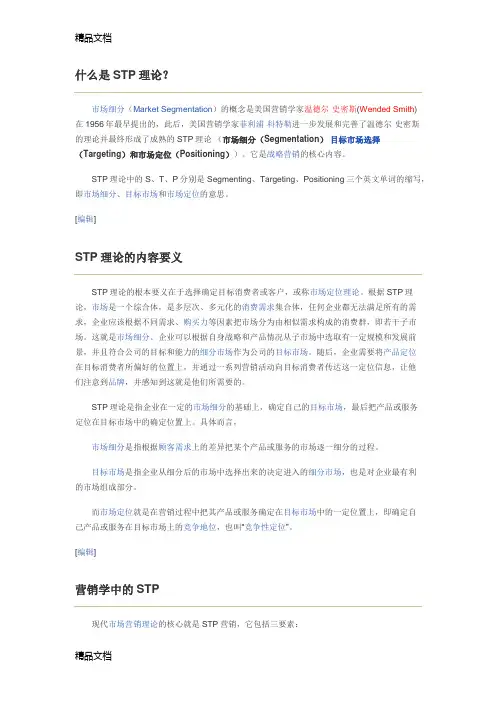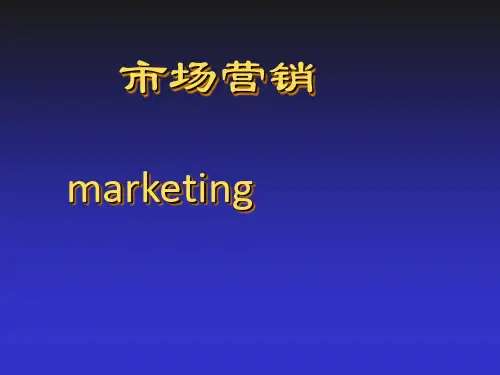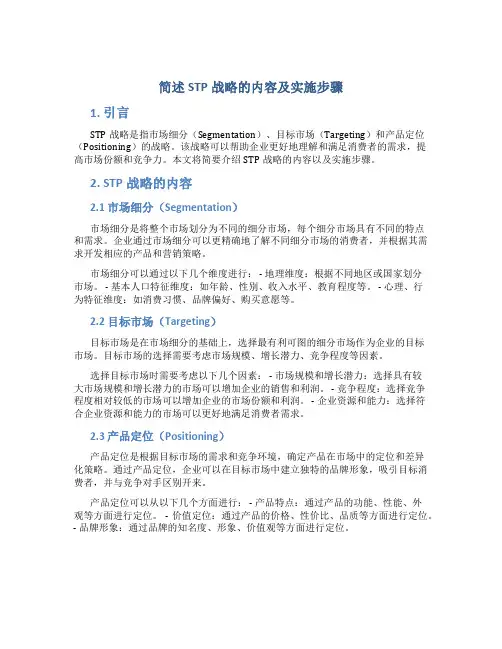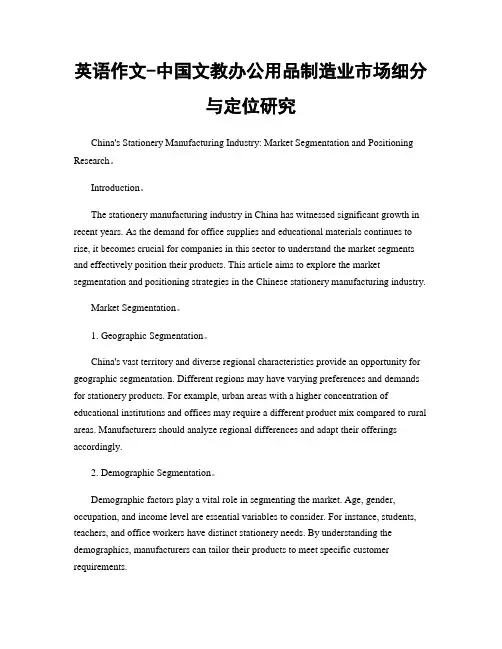市场细分和产品定位 英文精品
- 格式:ppt
- 大小:1.50 MB
- 文档页数:13

什么是STP理论?市场细分(Market Segmentation)的概念是美国营销学家温德尔·史密斯(Wended Smith)在1956年最早提出的,此后,美国营销学家菲利浦·科特勒进一步发展和完善了温德尔·史密斯的理论并最终形成了成熟的STP理论(市场细分(Segmentation)目标市场选择(Targeting)和市场定位(Positioning))。
它是战略营销的核心内容。
STP理论中的S、T、P分别是Segmenting、Targeting、Positioning三个英文单词的缩写,即市场细分、目标市场和市场定位的意思。
[编辑]STP理论的内容要义STP理论的根本要义在于选择确定目标消费者或客户,或称市场定位理论。
根据STP理论,市场是一个综合体,是多层次、多元化的消费需求集合体,任何企业都无法满足所有的需求,企业应该根据不同需求、购买力等因素把市场分为由相似需求构成的消费群,即若干子市场。
这就是市场细分。
企业可以根据自身战略和产品情况从子市场中选取有一定规模和发展前景,并且符合公司的目标和能力的细分市场作为公司的目标市场。
随后,企业需要将产品定位在目标消费者所偏好的位置上,并通过一系列营销活动向目标消费者传达这一定位信息,让他们注意到品牌,并感知到这就是他们所需要的。
STP理论是指企业在一定的市场细分的基础上,确定自己的目标市场,最后把产品或服务定位在目标市场中的确定位置上。
具体而言,市场细分是指根据顾客需求上的差异把某个产品或服务的市场逐一细分的过程。
目标市场是指企业从细分后的市场中选择出来的决定进入的细分市场,也是对企业最有利的市场组成部分。
而市场定位就是在营销过程中把其产品或服务确定在目标市场中的一定位置上,即确定自己产品或服务在目标市场上的竞争地位,也叫“竞争性定位”。
[编辑]营销学中的STP现代市场营销理论的核心就是STP营销,它包括三要素:市场细分(market segmentation)目标市场(market targeting)市场定位(market positioning)[编辑]市场细分市场细分的概念是美国市场学家温德尔·史密斯(Wendell R.Smith)于20世纪50年代中期提出来的。




简述STP战略的内容及实施步骤1. 引言STP战略是指市场细分(Segmentation)、目标市场(Targeting)和产品定位(Positioning)的战略。
该战略可以帮助企业更好地理解和满足消费者的需求,提高市场份额和竞争力。
本文将简要介绍STP战略的内容以及实施步骤。
2. STP战略的内容2.1 市场细分(Segmentation)市场细分是将整个市场划分为不同的细分市场,每个细分市场具有不同的特点和需求。
企业通过市场细分可以更精确地了解不同细分市场的消费者,并根据其需求开发相应的产品和营销策略。
市场细分可以通过以下几个维度进行: - 地理维度:根据不同地区或国家划分市场。
- 基本人口特征维度:如年龄、性别、收入水平、教育程度等。
- 心理、行为特征维度:如消费习惯、品牌偏好、购买意愿等。
2.2 目标市场(Targeting)目标市场是在市场细分的基础上,选择最有利可图的细分市场作为企业的目标市场。
目标市场的选择需要考虑市场规模、增长潜力、竞争程度等因素。
选择目标市场时需要考虑以下几个因素: - 市场规模和增长潜力:选择具有较大市场规模和增长潜力的市场可以增加企业的销售和利润。
- 竞争程度:选择竞争程度相对较低的市场可以增加企业的市场份额和利润。
- 企业资源和能力:选择符合企业资源和能力的市场可以更好地满足消费者需求。
2.3 产品定位(Positioning)产品定位是根据目标市场的需求和竞争环境,确定产品在市场中的定位和差异化策略。
通过产品定位,企业可以在目标市场中建立独特的品牌形象,吸引目标消费者,并与竞争对手区别开来。
产品定位可以从以下几个方面进行: - 产品特点:通过产品的功能、性能、外观等方面进行定位。
- 价值定位:通过产品的价格、性价比、品质等方面进行定位。
- 品牌形象:通过品牌的知名度、形象、价值观等方面进行定位。
3. STP战略的实施步骤STP战略的实施可以按照以下步骤进行: ### 3.1 研究市场首先,企业需要对市场进行彻底的研究。




英语作文-中国文教办公用品制造业市场细分与定位研究China's Stationery Manufacturing Industry: Market Segmentation and Positioning Research。
Introduction。
The stationery manufacturing industry in China has witnessed significant growth in recent years. As the demand for office supplies and educational materials continues to rise, it becomes crucial for companies in this sector to understand the market segments and effectively position their products. This article aims to explore the market segmentation and positioning strategies in the Chinese stationery manufacturing industry.Market Segmentation。
1. Geographic Segmentation。
China's vast territory and diverse regional characteristics provide an opportunity for geographic segmentation. Different regions may have varying preferences and demands for stationery products. For example, urban areas with a higher concentration of educational institutions and offices may require a different product mix compared to rural areas. Manufacturers should analyze regional differences and adapt their offerings accordingly.2. Demographic Segmentation。

英语作文-医学护肤品制造行业的市场细分与产品定位策略The Market Segmentation and Product Positioning Strategy in the Medical Skincare Manufacturing Industry。
In recent years, the medical skincare manufacturing industry has witnessed significant growth and development. With the increasing demand for skincare products and the advancement of medical technology, it has become crucial for companies in this industry to effectively segment their market and position their products strategically. This article will explore the market segmentation and product positioning strategy in the medical skincare manufacturing industry.Market segmentation plays a vital role in identifying and targeting specific customer groups. In the medical skincare manufacturing industry, market segmentation can be based on various factors such as age, gender, skin type, and specific skincare needs. By dividing the market into smaller segments, companies can better understand their customers' preferences and tailor their products accordingly.One of the key market segments in the medical skincare manufacturing industry is age. Different age groups have distinct skincare needs and concerns. For instance, younger individuals may focus more on preventing acne and maintaining a youthful appearance, while older individuals may prioritize anti-aging and wrinkle reduction. By developing skincare products specifically designed for different age groups, companies can effectively meet their customers' needs and gain a competitive advantage.Gender is another important factor in market segmentation. Men and women have different skincare requirements and preferences. While women often seek products that address issues such as hydration, brightening, and anti-aging, men may prioritize products that offer oil control and soothing properties. By creating gender-specificskincare lines, companies can cater to the unique needs of each gender and enhance customer satisfaction.Skin type is another crucial aspect of market segmentation in the medical skincare manufacturing industry. Different skin types, such as oily, dry, combination, and sensitive, require specific formulations and ingredients. By developing products tailored to each skin type, companies can effectively address their customers' concerns and provide personalized solutions.Furthermore, market segmentation can be based on specific skincare needs. Some individuals may suffer from skin conditions such as acne, rosacea, or hyperpigmentation. By offering specialized products that target these specific concerns, companies can attract a niche market and establish themselves as experts in addressing these skincare issues.Once the market segments have been identified, companies need to strategically position their products to effectively reach their target customers. Product positioning involves creating a distinct image and value proposition for the product in the minds of consumers. This can be achieved through various strategies such as product differentiation, pricing, and branding.Product differentiation is crucial in the medical skincare manufacturing industry, where competition is fierce. By offering unique features, ingredients, or benefits, companies can set their products apart from competitors and attract customers. For example, a company may develop a skincare product that combines medical-grade ingredients with natural extracts, providing a unique selling point that appeals to health-conscious consumers.Pricing is another important aspect of product positioning. Companies can position their products as high-end, premium options by pricing them at a higher range. This strategy targets consumers who associate higher prices with superior quality and effectiveness. On the other hand, companies can also position their products as affordable alternatives, targeting price-sensitive customers who still seek quality skincare solutions.Branding plays a significant role in product positioning as well. By creating a strong brand image and reputation, companies can establish trust and loyalty among consumers. This can be achieved through consistent messaging, quality assurance, and endorsements from skincare professionals or celebrities. A well-established brand can position its products as reliable and effective choices, attracting customers who value credibility and authenticity.In conclusion, the medical skincare manufacturing industry can effectively segment its market based on age, gender, skin type, and specific skincare needs. By understanding their target customers' preferences and concerns, companies can develop products that meet their needs and gain a competitive advantage. Strategic product positioning through differentiation, pricing, and branding further enhances companies' ability to attract and retain customers in this highly competitive industry.。